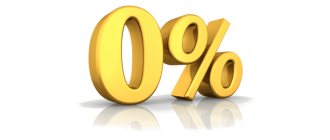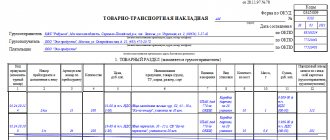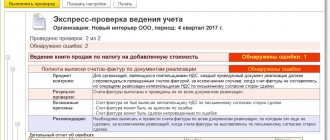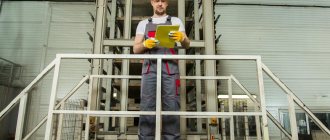Home / Taxes / What is VAT and when does it increase to 20 percent? / VAT object
Back
Published: December 28, 2017
Reading time: 6 min
0
543
As is known, the Russian system of taxation of goods and services is regulated by the use of three VAT tax rates: basic 18%, reduced 10% and zero rate if the goods correspond to legally designated preferential categories. Let's consider in detail : which goods are included in the list of the reduced rate of 10%, and which will be subject to VAT in the amount of 18%.
- For which goods does a reduced VAT of 10% apply? Category of food products
- Product category for children
- Category of books and printed products
- Category of medical products
- Agriculture
The most important changes in VAT 2019
From 2021, the basic VAT rate has been increased to 20 percent (Federal Law No. 303-FZ dated August 3, 2018). See “ Law on increasing VAT from 18 to 20 percent .”
Story
Let us recall that a rate of 20% was in force in our country from 1994 to 2004, and in the two years preceding this period it was even higher and amounted to 28%. Since 2004, the VAT rate has been 18 percent and has not increased.
The 10% VAT rate for food and children's goods remains. In addition, until 2025, a zero VAT rate was fixed for air transportation to Crimea and Sevastopol. Also, a zero rate was provided for air transportation to the regions of the Far Eastern Federal District and the Kaliningrad region.
VAT (or value added tax) is an indirect form of tax levied for the benefit of the state budget by a special federal tax service on the additional value added to goods and services at each stage of their production. This tax is the most easily administered tax, therefore it is one of the main tax levies in the Russian Federation. However, its main payer is not individual entrepreneurs and other legal entities (in the main taxation system), but the consumer, who is the last link in the commodity production chain. Most companies use the fees in question not to reduce their profits, but to increase the price of a product or service.
The tax in question was first applied on Jan. 1. 1992 in accordance with Federal Law No. 1992-1 (dated December 6, 1991). Later, in 2001, 21 chapters were included in the tax code, regulating and explaining VAT for the present period.
Table. Changes in the VAT rate by year in Russia:
| Year | Basic, percentage | Preferential, percentage |
| 1992 | 28 | 15 and 0 |
| 1993 | 20 | 10 and 0 |
| 1994 | 20 | 10 and 0 |
| 1995 | 20 | 10 and 0 |
| 1996 | 20 | 10 and 0 |
| 1997 | 20 | 10 and 0 |
| 1998 | 20 | 10 and 0 |
| 1999 | 20 | 10 and 0 |
| 2000 | 20 | 10 and 0 |
| 2001 | 20 | 10 and 0 |
| 2002 | 20 | 10 and 0 |
| 2003 | 20 | 10 and 0 |
| 2004 | 18 | 10 and 0 |
| 2005 | 18 | 10 and 0 |
| 2006 | 18 | 10 and 0 |
| 2007 | 18 | 10 and 0 |
| 2008 | 18 | 10 and 0 |
| 2009 | 18 | 10 and 0 |
| 2010 | 18 | 10 and 0 |
| 2011 | 18 | 10 and 0 |
| 2012 | 18 | 10 and 0 |
| 2013 | 18 | 10 and 0 |
| 2014 | 18 | 10 and 0 |
| 2015 | 18 | 10 and 0 |
| 2016 | 18 | 10 and 0 |
| 2017 | 18 | 10 and 0 |
| 2018 | 18 | 10 and 0 |
| 2019 | 20 | 10 and 0 |
| 2020 | 20 | 10 and 0 |
*0 - mainly established for enterprises extracting raw materials (oil, gas production and other resources), as well as organizations carrying out sales and supplies abroad (regulated by Article 164, paragraph 1 of the Tax Code); *10 - mainly used in the sale of food, medicine, printed materials, children's goods and air transportation.
Schedule:
From the above data it is clear that the highest value for the analyzed tax collection was in 1992, immediately after the collapse of the USSR, which took place on December 25, 1991. This level was introduced in order to maintain budgetary filling during the formation of the Russian Federation. In 1993, all the main reforms and transformations in the Russian Federation took place and therefore the government apparatus decided to reduce the VAT to twenty percent, which lasted until 2003.
In 2003, there were top oil prices, and the state had a need for additional investments to stimulate the country’s economic growth, therefore, in order to improve the investment climate, a decision was made to reduce the tax burden on the real sector of the economy.
According to many economists and experts, the high rate of this tax “kills” high-value production with high added value, since due to significant VAT taxes, entrepreneurs are forced to increase the cost of their products, which in modern conditions cannot compete with foreign goods. A striking example of such production is aircraft manufacturing, mechanical engineering (machine tools, tractors, etc.) and others.
The reason for the next rate increase from January 1, 2021 was the need to finance the planned national projects of the Russian Federation, which are planned to be implemented before 2024. There were big discussions about the latest changes in the government and the State Duma, and there was no clear opinion in favor of an increase among those who voted for adoption. According to economic bloc estimates, increasing the rate for this tax collection will bring 633.5 billion rubles to the federal budget in 2019. At the same time, in 2021 - 678 billion rubles, and in 2021 - 728 billion rubles.
According to many experts, in order to ensure the economic breakthrough that the president announced in 2021, the state must begin to pursue a policy of protectionism in the same way as the leaders of other countries do: Trump (USA), Xi Jin Pin (China) and others - reduce taxes on business in order to stimulate production growth, revive the domestic market, and also increase the incomes of its own citizens, who will be able to ensure a high level of consumption of goods in the domestic market. Only such measures can provoke significant GDP growth in the next few years and bring Russia into the top five countries in terms of contribution to global gross domestic product.
However, currently ongoing reforms and policies are more focused on external consumers in the hope that one day our products will be competitive and in demand in foreign markets. Currently, the state’s emphasis is not on reducing the net export of raw materials and increasing the commodity redistribution, but, on the contrary, on an even greater dependence of the economy and budget on the sale of raw materials and their prices on the world market. It is this policy that leads to a decrease in production volumes, the closure of enterprises and a decrease in the incomes of Russians.
2021 Betting Options
In 2021, there are several basic rates for calculating VAT - 20%, 10% and 0%, and several calculated rates - 20/120, 10/110 and 16.67%, which are used depending on the type of transaction:
Rate 20% percent
This is a general rate that applies to most transactions (clause 3 of Article 164 of the Tax Code of the Russian Federation). At this rate, tax transactions that are not specified in the Tax Code of the Russian Federation as grounds for applying other rates.
A 20% rate applies to most transactions. Until 2021, it was 18%. In this regard, transactions that were previously taxed at a rate of 18% will be taxed at a rate of 20% from 01/01/2019. There may be situations where different VAT rates will be applicable within the same transaction. In this case, it is important to correctly determine the tax rate for a specific transaction.
Rate 10 percent
The rate at which tax is calculated on the import and sale of certain goods, as well as on the sale of certain services. In paragraph 2 of Art. 164 of the Tax Code of the Russian Federation indicates goods and services, and in the lists approved by the Government of the Russian Federation - product codes. For example, this rate is applied when selling food or medical goods (clause 2 of article 164 of the Tax Code of the Russian Federation).
A rate of 10% can be called reduced. It is used for the import and sale of socially significant goods, as well as for the sale of certain services.
Rate 0% percent
Applicable for export, international transport and other operations listed in paragraph 1 of Art. 164 Tax Code of the Russian Federation.
The 0% rate is provided mainly for export operations and for the transport of goods, passengers and luggage. Estimated rates are used for calculating VAT on prepayments, as well as for other cases when VAT is included in the tax base and needs to be extracted from there rather than charged on top of the price.
Rates 20/120 or 10/110
These are estimated rates that are used in cases where the tax base includes VAT. The main cases are listed in paragraph 4 of Art. 164 Tax Code of the Russian Federation. For example, receiving advances, withholding VAT by a tax agent. A settlement rate of 20/120 or 10/110 is applied depending on the rate at which the main transaction is taxed.
Similar rates are used if it is necessary not to calculate VAT at the rate, but, on the contrary, to isolate it from the total payment amount. They are needed, for example, if the seller receives an advance payment for future delivery of goods or provision of services. Also, these estimated rates are used when VAT is transferred to the budget by a tax agent. And another case is when there is an assignment of monetary claims by a new creditor.
And the calculated rates of 10/110 and 20/120 differ from each other in the amount of VAT that is levied on a particular product (transaction). If there was a preferential rate of 10%, then the first option is taken into account. If 20 percent, then the second one.
Rate 16.67%
A special settlement rate, which is applied only in two cases: when selling an enterprise as a whole as a property complex and when foreign companies provide services to individuals in electronic form (clause 4 of article 158, clause 5 of article 174.2 of the Tax Code of the Russian Federation).
Estimated rate increase from 2021: The estimated tax rate will increase from 15.25 percent to 16.67 percent. “Calculation method” means: 16.67 = 20/120.
For which goods the VAT rate is 10%
A complete and exhaustive list of goods at a VAT rate of 10 percent 2021 is given in paragraph 2 of Article 164 of the Tax Code of the Russian Federation. It includes socially significant products.
IMPORTANT!
On December 31, 2021, the preferential rate for domestic air passenger transportation and baggage delivery, which was not subject to the zero value added tax tariff according to paragraphs. 4.1 - 4.3 clause 1 art. 164.
A special feature of the preferential tariff is that the specific name of the product indicating the HS code is approved by the Government of the Russian Federation. If the code of the product being sold is not approved by the resolution, then the taxpayer does not have the right to apply a reduced value added tax rate.
| View | List of paragraph 2 of Art. 164 | Decree of the Government of the Russian Federation approving HS codes and names of preferential products |
| List of medical goods with VAT 10 |
| No. 688 dated September 15, 2008 |
| Food |
and further according to paragraphs. 1 item 2 art. 164 | No. 908 dated December 31, 2004 |
| Printed products |
pp. 3 p. 2 art. 164 | No. 41 from 01/23/2003 |
| List of children's products with VAT 10 |
pp. 2 p. 2 art. 164 | No. 908 dated December 31, 2004 |
Betting table 2021
The table below contains the new VAT rates that will apply from 01/01/2019:
| Bid | Application area |
| 0% | · Sale of goods intended for export, passing through customs clearance. |
| · International shipping. | |
| · Operations carried out by organizations for the transportation of oil and its products. | |
| 10% | · Sales of food products. |
| · Sales of children's goods. | |
| · Sales of medicines and medical products. | |
| · Sales of printed and periodicals related to the field of education and culture. | |
| 20% | All other transactions that do not fall into the previous two categories |
MINIMUM TAX
The tax, calculated as a percentage of the tax base corresponding to the tax rate, cannot be less than the amount of the minimum tax.
The minimum tax is calculated as a percentage of the minimum tax base corresponding to the tax rate.
For subsoil areas specified in subparagraphs 1, 2 and 4 of paragraph 1 of Article 333.45 of the Tax Code of the Russian Federation, for which for all tax periods in relation to oil extracted from such subsoil areas, a Kg coefficient of less than 1 was applied, the minimum tax base is assumed to be 0.
In all other cases, the minimum tax base is determined as the amount of estimated revenue from the sale of hydrocarbons at a subsoil site for the tax (reporting) period, successively reduced by:
— estimated expenses on the subsoil plot for the tax (reporting) period;
— actual expenses on the subsoil plot for the tax (reporting) period in terms of tax amounts;
— the amount of marginal costs for the production of hydrocarbons, determined as the product of the amount of oil produced during the tax (reporting) period at a subsoil site, and the value of specific costs in the amount of 9,520 rubles.
For tax periods 2021–2021, the value of specific expenses is recognized as equal to 7,140 rubles.
The value of unit costs is subject to annual indexation by the amount of the accumulated consumer price index starting from 2021.
If the minimum tax base takes a negative value, the minimum tax base is taken equal to zero.
Reflection of VAT in the invoice from 2019
When filling out an invoice in 2021, you must indicate two values:
- the total cost of goods or services;
- the required VAT rate in Russia.
If we are talking about rates of 0, 10 and 20 percent, then column No. 7 is filled out in this document. When we are dealing with calculated rates of 10/110 and 20/120, the fifth column is intended for them (see the figure below). It is only important to take into account that in the last two cases, the full amount must be indicated in the “Cost of goods and services” column. And depending on the specified rate, inspectors will understand whether it includes VAT or whether it has yet to be calculated.
From 2021, the form will remain the same, but column 7 “Tax rate” must be filled out in a new way (in accordance with the requirements of Federal Law No. 303 dated August 3, 2018). Instead of the rate of 18% there will be 20%, and instead of the calculated rate of 15.25% - 16.67% (20/120).
Read also
10.10.2018
What has changed since July 1, 2021
In the fourth quarter of 2021, fruits and berries were included in the list of preferential socially significant products, and palm oil was excluded.
From July 1, 2021, VAT 10 percent will be added to the 2021 list of food products with milk fat substitute (Resolution of the Government of the Russian Federation dated 03/09/2020 No. 250). To determine which products belong to this category, we turn to the Technical Regulations of the Customs Union “On the safety of milk and dairy products” TR CU 033/2013. He gives the following definitions:
From July 1, 2021, the list of products at the 10% VAT rate containing milk and its substitutes has included:
- products produced using cheese technology;
- drinks, cocktails, jelly;
- jellies, sauces, creams, puddings, mousses, pastes and soufflés;
- canned food and dry products, condensed canned food;
- ice cream containing milk.
Legal documents
- Article 164 of the Tax Code of the Russian Federation
- No. 688 dated September 15, 2008
- No. 908 dated December 31, 2004
- No. 41 from 01/23/2003
- Decree of the Government of the Russian Federation dated 03/09/2020 No. 250
- Technical Regulations of the Customs Union “On the safety of milk and dairy products” TR CU 033/2013









